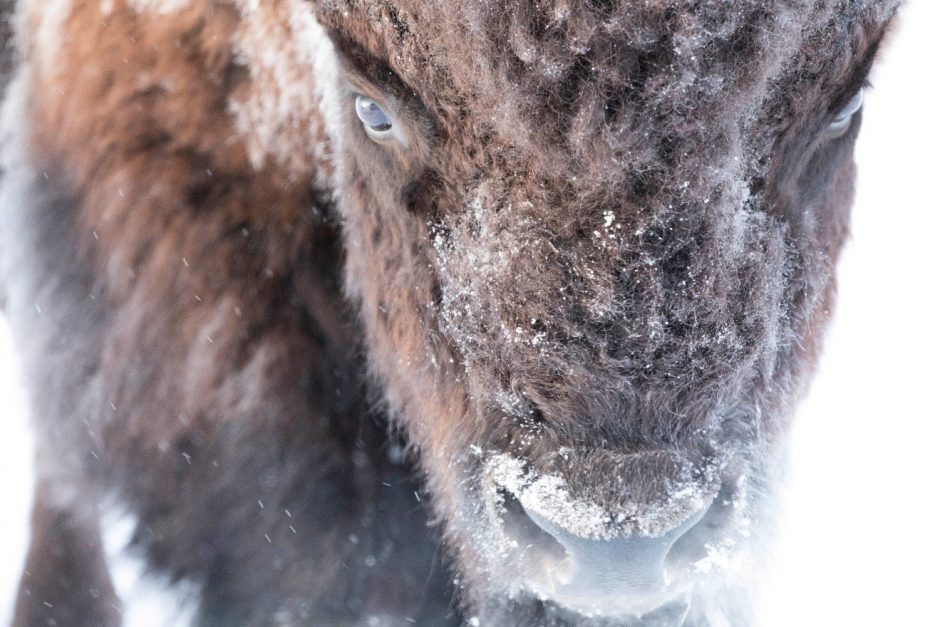
How to get this shot – Snowy Bison
It’s prime time for winter photography, and there may be no better place than Yellowstone in the winter to get the shots you’ve always wanted. From snowy Grand Tetons, to wildlife roaming free, it offers the nature photography everything they want.
If you’re headed to Yellowstone this winter, or anywhere there is snow and bison, follow these steps to capture your own photo like the one above.
- The first step is getting in-location for something like this. While American bison do have a relatively extensive range, there’s nothing like Yellowstone National Park to deliver on this for you. The key is to do your homework ahead of time, or go with a reputable outfitter (of course I’m partial to Natural Habitat Adventures), as there are a number of roads closed, only accessible by all-terrain vehicle at this time of year. Nevertheless, the northern Lamar Valley road is open and heading out to Cooke City is a great way to get in range.
- The great thing about a shot like this is that you don’t have to worry too much about the weather. Blue skies above? Great! Cloudy and snowy? Great! This is key in winter-time photography, as you never know what the weather is going to do in mountainous terrain from day to day.
- For this shot, you’ll need some sort of telephoto lens. Or if you’re using a point and shoot, at least a 6x or 10x zoom capability. Fortunately, because bison are abundant, you don’t need anything really extreme telephoto, for they are found everywhere adn in close proximity. For DSLR and mirrorless users out there, a 200mm or 300mm full-frame-equivalent focal length is just fine.
- In my opinion, the real key to this shot is the shallow depth of field. I am shooting at f/5.6, which is moderate. You could even go down to f/4.0 and get more pleasing blurred effects. The fact that the body is blurred and face in focus does a few things. One, it helps make the face (and eye) look even more sharply in focus. The contrast of blur to focus makes that which is in focus appear even more so. The second reason is to show depth, while not letting the viewer get “distracted” by the texture, color, and contrast of the body fur in the background part of the frame. If everything were in focus, it would be a bit too “busy” in the frame, and detract from the ultimate impression of this photo.
- Next, you’ll want to make sure that you nail the composition. I chose to have the face fill the frame, taking up nearly two-thirds of the shot. This gives the face prominence, and having the dusting of snow, combined with heated breath, really puts it all into interesting context. However, I do want to include a little bit of the white background, even if you can’t tell what it is. Because this bright white helps provide context to the area you’ve photographed this critter. Even just a little bit of white peeking through the legs connects the viewer with a stark, wintery landscape. If you aren’t yet familiar with some of the general rules of composition, it’s worth taking a read HERE.
- Finally, you’ll want to focus on the eye, hold the shutter down half-way, recompose your shot, and then fire away. This sort of photo does require patience, as not every bison you may encounter will a) look right at you, b) have some snow on the fur, and c) be exhaling at just the right moment. So, you’ll have to create a bit of your own luck and spend some time before you get this shot. But, when you do get it, it’s sure to be a wonderful way to remember your winter photo experience, no matter where in the world you make it.
While this lesson can be used on other wildlife, there’s something about the American bison that makes this type of photo extra compelling. I think it’s the shape of the body (which can help fill the frame), the uniqueness of the face and fur, as well as where it chooses to make it’s winter home…in snowy, snowy places. Nevertheless, the best way to master these techniques is to get out there and practice.
Now get out there and give it a shot!
All the best,
2 Comments

Tesflex
February 24, 2018 at 11:39 am

Court Whelan, Ph.D.
March 9, 2018 at 2:02 pm
Court Whelan, Ph.D., thank you ever so for you post.Much thanks again.
you’re very welcome!